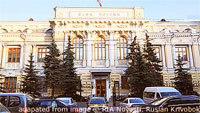Russia’s new regulatory overlord

(Business New Europe – bne.eu – Ben Aris in Moscow – September 25, 2013) Russia leapt 10 places in the latest “Economic Freedom of the World” report, released in September by Canada’s Fraser Institute, to 101st place largely thanks to its financial reforms. The US fell 13 spots, largely because of its financial mess. The Kremlin is regularly lambasted for failing to make structural reforms, but the one thing it is good at – better than nearly any other emerging market, according to the World Bank – is sorting out its financial sector. Everyone in Russia is thinking about money these days.
Russia runs one of the most open and internationalised financial sectors of any of the major emerging markets. Unlike many its capital account is completely open, which allows money to flow in and out of the country more-or-less without restrictions, and it even beats the US in the efficiency of its tax administration, according to the most recent “Doing Business” report from the World Bank.
The government put another piece in place on September 1 when it merged the securities market regulator, the Federal Securities Service, with the Central Bank of Russia to create a so-called super-regulator. From now on, in effect the central bank will be responsible for any and all financial businesses – from pensions, through to stocks and on to setting interest rates and running monetary policy.
Step by step
The creation of a mega-regulator has been discussed for more than a decade, but since April 2008, when the state launched its Moscow as an International Financial Capital programme, the previous turf wars that had hamstrung any changes have been swept away and one important reform after another fell into place – the 2008 global financial meltdown notwithstanding.
The first major change was a merger between Russia’s two leading exchanges, Micex and RTS, completed in December 2011. That was followed by connecting the newly minted Moscow Exchange to the international capital market by signing up to the international settlement systems Clearstream and Euronext, which went live at the start of this year.
The next big event will come on January 1, 2014 when domestically traded equities are included in the international settlement system. In a preview of what that might mean: the government was expecting foreign investors to buy some $5bn of Russian domestic bonds once they could trade directly on the Russian market, but the actual volume this year has been closer to $20bn. Indeed, this reform has been so successful that the central bank is now worried about too much foreign capital flowing into the domestic market. In August, the CBR increased the risk assessment for foreign borrowing to “high risk”, which will make foreign borrowing more costly and force banks to keep larger prudential reserves as a way to slow the pace somewhat.
The regulatory reform has been well received by Russia’s professional investors, as it normalises the market structures and brings them in line with international norms. “The Central Bank of Russia’s new role as a ‘mega-regulator’ overseeing commercial banks and nonbank financial institutions is likely to standardize regulation and reporting among the various entities and could be positive for ratings in the Russian financial sector in the long run,” Standard & Poor’s said in an assessment after the mega-regulator went live.
In parallel with the new body, the CBR has accelerated Russia’s effort to comply with the so-called Basel III criteria – tough new prudential rules that will improve the stability of the banking sector further. Reserves that banks need to hold against the possibility of loans going bad (especially retail loans) have been dramatically increased, a raft of new rules to tighten control over Russian banks’ sources of capital are in place and stricter related-party lending regulations have been introduced.
All these changes are very timely, as despite the relative health of the banking sector, it remains under pressure from the soggy global growth externally and the lack of confidence internally. The upshot is that banks are increasingly having to rely on the state’s copious reserves for cash. At the same time, their lending business is very lopsided: consumer loans have been growing by 40% a year for the last few years (although slowing now), however corporate lending is virtually stagnant. Banks are thirsty for funds, but are unable to make profits from their traditional lending business.
“There is still a lot to do, but the creation of the mega-regulator is another sign for foreign investors that Russia wants to be a full and modern member of the world financial and commercial economy,” says Geoffrey Nicholson, a partner at PricewaterhouseCoopers.
